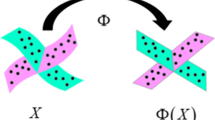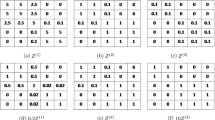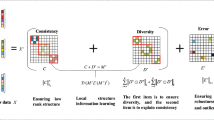Abstract
Recently, multi-view subspace clustering has attracted intensive attentions due to the remarkable clustering performance by extracting abundant complementary information from multi-view data, making its clustering performance much better than that of single view data. However, at present, multi-view subspace clustering methods develop either a shared consistency representation that models the common properties from all views, or a series of specificity representations each of which mines the intrinsic difference in each view, or global spatial structure of all features, or local geometric structure of multiple features. More seriously, only one kind of information is extracted and utilized in some research work. In this paper, to cope with the issue, we present a multiple kinds of information extraction method (MKIE) for multi-view subspace clustering, which combines the consistency and specificity regularizations with the graph regularizations. We construct some graph structures for the shared consistency representation and all the specificity representations, which model the local geometric structures of multiple features. The model of MKIE makes full use of four kinds of valid information: global spatial structure information, local geometric structure information, consistent feature information and specific feature information. In addition, we design an effective optimization algorithm based on Alternating Direction Method of Multipliers. Extensive experiments performed on four benchmark multi-view datasets validate the effectiveness of MKIE which is compared with ten state-of-the-art multi-view clustering methods.




Similar content being viewed by others
Data availability
The BBC-SPORTS dataset [78] is available in ML Resources whose URL is http://mlg.ucd.ie/datasets/segment.html. The ALOI dataset [79] is available in ELKI Data Mining whose URL is http://elki.dbs.ifi.lmu.de/wiki/DataSets/MultiView. The Prokaryotic-phyla dataset [80] is available in ProTraits whose URL is http://protraits.irb.hr/. The Caltech101 dataset [81] is available in Caltech Vision Lab whose URL is http://www.vision.caltech.edu/datasets/.
References
Mirkin B (2005) Clustering for data mining: a data recovery approach. Chapman & Hall/CRC, Los Angeles
Fu L, Lin P, Vasilakos AV et al (2020) An overview of recent multi-view clustering. Neurocomputing 402:148–161
Xie Y, Lin B, Qu Y et al (2020) Joint deep multi-view learning for image clustering. IEEE Trans Knowl Data Eng 33(11):3594–3606
Zhao J (2022) A novel low-rank matrix approximation algorithm for face denoising and background/foreground separation. Comput Appl Math 41(4):1–38
Bertsimas D, Orfanoudaki A, Wiberg H (2021) Interpretable clustering: an optimization approach. Mach Learn 110(1):89–138
Ghadiri S, Mazlumi K (2020) Adaptive protection scheme for microgrids based on SOM clustering technique. Appl Soft Comput 88:106062
Kouhi A, Seyedarabi H, Aghagolzadeh A (2020) Robust FCM clustering algorithm with combined spatial constraint and membership matrix local information for brain MRI segmentation. Expert Syst Appl 146:113159
Lu C, Feng J, Lin Z et al (2018) Subspace clustering by block diagonal representation. IEEE Trans Pattern Anal Mach Intell 41(2):487–501
Zhao J, Zhao L (2020) Low-rank and sparse matrices fitting algorithm for low-rank representation. Comput Math Appl 79(2):407–425
Baker Y, Tang T, Allen G (2020) Feature selection for data integration with mixed multiview data. Annals of Applied Statistics 14(4):1676–1698
Liu X, Li M, Tang C et al (2020) Efficient and effective regularized incomplete multi-view clustering. IEEE Trans Pattern Anal Mach Intell 43(8):2634–2646
Li R, Zhang C, Fu H, et al (2019) Reciprocal multi-layer subspace learning for multi-view clustering. Proceedings of the IEEE/CVF International Conference on Computer Vision 8172–8180
Yang Z, Xu Q, Zhang W et al (2019) Split multiplicative multi-view subspace clustering. IEEE Trans Image Process 28(10):5147–5160
Zhao J, Feng Q, Zhao L (2019) Alternating direction and Taylor expansion minimization algorithms for unconstrained nuclear norm optimization. Numerical Algorithms 82(1):371–396
Zhang X, Sun H, Liu Z et al (2019) Robust low-rank kernel multi-view subspace clustering based on the Schatten p-norm and correntropy. Inf Sci 477:430–447
Peng X, Huang Z, Lv J, et al (2019) COMIC: multi-view clustering without parameter selection. International Conference on Machine Learning 5092–5101
Huang S, Kang Z, Tsang I et al (2019) Auto-weighted multi-view clustering via kernelized graph learning. Pattern Recogn 88:174–184
Yu H, Wang X, Wang G et al (2020) An active three-way clustering method via low-rank matrices for multi-view data. Inf Sci 507:823–839
Yin M, Gao J, Xie S et al (2018) Multiview subspace clustering via tensorial t-product representation. IEEE Transactions on Neural Networks and Learning Systems 30(3):851–864
Chen Y, Xiao X, Zhou Y (2020) Multi-view subspace clustering via simultaneously learning the representation tensor and affinity matrix. Pattern Recogn 106:107441
Gao Q, Xia W, Wan Z et al (2020) Tensor-SVD based graph learning for multi-view subspace clustering. Proceedings of the AAAI Conference on Artificial Intelligence 34(04):3930–3937
Zhu X, Zhang S, He W et al (2018) One-step multi-view spectral clustering. IEEE Trans Knowl Data Eng 31(10):2022–2034
Wang Y, Wu L, Lin X et al (2018) Multiview spectral clustering via structured low-rank matrix factorization. IEEE Transactions on Neural Networks and Learning Systems 29(10):4833–4843
Wang Y, Wu L (2018) Beyond low-rank representations: Orthogonal clustering basis reconstruction with optimized graph structure for multi-view spectral clustering. Neural Netw 103:1–8
Sharma K, Seal A (2021) Multi-view spectral clustering for uncertain objects. Inf Sci 547:723–745
Wang H, Yang Y, Liu B et al (2019) A study of graph-based system for multi-view clustering. Knowl-Based Syst 163:1009–1019
Zhang C, Fu H, Hu Q et al (2018) Generalized latent multi-view subspace clustering. IEEE Trans Pattern Anal Mach Intell 42(1):86–99
Brbić M, Kopriva I (2018) Multi-view low-rank sparse subspace clustering. Pattern Recogn 73:247–258
Luo S, Zhang C, Zhang W et al (2018) Consistent and specific multi-view subspace clustering. Proceedings of the AAAI Conference on Artificial Intelligence 32(1):3110–3126
Zhang G, Zhou Y, He X et al (2020) One-step kernel multi-view subspace clustering. Knowl-Based Syst 189:105126
Zheng Q, Zhu J, Li Z et al (2020) Feature concatenation multi-view subspace clustering. Neurocomputing 379:89–102
Wang H, Yang Y, Liu B (2019) GMC: Graph-based multi-view clustering. IEEE Trans Knowl Data Eng 32(6):1116–1129
Zhao L, Chen Z, Yang Y et al (2018) Incomplete multi-view clustering via deep semantic mapping. Neurocomputing 275:1053–1062
Jing P, Su Y, Li Z et al (2021) Learning robust affinity graph representation for multi-view clustering. Inf Sci 544:155–167
Wu J, Xie X, Nie L et al (2020) Unified graph and low-rank tensor learning for multi-view clustering. Proceedings of the AAAI Conference on Artificial Intelligence 34(04):6388–6395
Tang C, Liu X, Zhu X et al (2020) CGD: Multi-view clustering via cross-view graph diffusion. Proceedings of the AAAI Conference on Artificial Intelligence 34(04):5924–5931
Li L, He H (2020) Bipartite graph based multi-view clustering. IEEE Transactions on Knowledge and Data Engineering 34(7):3111–3125
Xia W, Wang Q, Gao Q et al (2021) Self-supervised graph convolutional network for multi-view clustering. IEEE Transact Multimedia 24:3182–3192
Li J, Zhou G, Qiu Y et al (2020) Deep graph regularized non-negative matrix factorization for multi-view clustering. Neurocomputing 390:108–116
Li Z, Tang C, Liu X et al (2021) Consensus graph learning for multi-view clustering. IEEE Transact Multimedia 24:2461–2472
Wang Y, Chang D, Fu Z et al (2021) Consistent multiple graph embedding for multi-view clustering. IEEE Transact Multimedia 25:1008–1018
Huang S, Tsang I, Xu Z et al (2021) Measuring diversity in graph learning: a unified framework for structured multi-view clustering. IEEE Transact Knowledge Data Eng 34(12):5869–5883
Yang B, Zhang X, Chen B et al (2022) Efficient correntropy-based multi-view clustering with anchor graph embedding. Neural Netw 146:290–302
Shi S, Nie F, Wang R et al (2021) Multi-view clustering via nonnegative and orthogonal graph reconstruction. IEEE Transactions on Neural Networks and Learning Systems 34(1):201–214
Shi S, Nie F, Wang R et al (2021) Fast multi-view clustering via prototype graph. IEEE Transactions on Knowledge and Data Engineering 35(1):443–455
Mei Y, Ren Z, Wu B et al (2022) Robust graph-based multi-view clustering in latent embedding space. Int J Mach Learn Cybern 13(2):497–508
Wang R, Li L, Tao X et al (2022) Contrastive and attentive graph learning for multi-view clustering. Inf Process Manage 59(4):102967
Li M, Liang W, Liu X (2021) Multi-view clustering with learned bipartite graph. IEEE Access 9:87952–87961
Shu X, Zhang X, Wang Q (2022) Self-weighted graph learning for multi-view clustering. Neurocomputing 501:188-196
Gu Z, Feng S (2022) Individuality meets commonality: a unified graph learning framework for multi-view clustering. ACM Trans Knowl Disc Data 17(1):1–21
Liu L, Chen P, Luo G et al (2022) Scalable multi-view clustering with graph filtering. Neural Comput Appl 34(19):16213–16221
Lu X, Feng S (2022) Structure diversity-induced anchor graph fusion for multi-view clustering. ACM Trans Knowl Disc Data 17(2):1–18
Lu H, Gao Q, Zhang X et al (2022) A multi-view clustering framework via integrating k-means and graph-cut. Neurocomputing 501:609–617
Jiang T, Gao Q, Gao X (2021) Multiple graph learning for scalable multi-view clustering. arXiv preprint arXiv: 2106.15382
Wang C, Geng L, Zhang J et al (2022) Multi-view clustering via robust consistent graph learning. Digit Signal Process 128:103607
Yang B, Zhang X, Lin Z et al (2022) Efficient and robust multi-view clustering with anchor graph regularization. IEEE Transactions on Circuits and Systems for Video Technology 32(9):6200–6213
Jiang G, Peng J, Wang H et al (2022) Tensorial multi-view clustering via low-rank constrained high-order graph learning. IEEE Transactions on Circuits and Systems for Video Technology 32(8):5307–5318
Gao Q, Xia W, Gao X et al (2021) Effective and efficient graph learning for multi-view clustering. arXiv preprint arXiv: 2108.06734
Huang S, Kang Z, Xu Z (2020) Auto-weighted multi-view clustering via deep matrix decomposition. Pattern Recogn 97:107015
Xu J, Ren Y, Li G et al (2021) Deep embedded multi-view clustering with collaborative training. Inf Sci 573:279–290
Wang Q, Cheng J, Gao Q et al (2020) Deep multi-view subspace clustering with unified and discriminative learning. IEEE Trans Multimedia 23:3483–3493
Liu J, Cao F, Gao X et al (2020) A cluster-weighted kernel K-means method for multi-view clustering. Proceedings of the AAAI Conference on Artificial Intelligence 34(04):4860–4867
El Hajjar S, Dornaika F, Abdallah F et al (2022) Consensus graph and spectral representation for one-step multi-view kernel based clustering. Knowl-Based Syst 241:108250
Zhu W, Lu J, Zhou J (2019) Structured general and specific multi-view subspace clustering. Pattern Recogn 93:392–403
Li Z, Tang C, Chen J et al (2019) Diversity and consistency learning guided spectral embedding for multi-view clustering. Neurocomputing 370:128–139
Mi Y, Ren Z, Mukherjee M et al (2021) Diversity and consistency embedding learning for multi-view subspace clustering. Appl Intell 51(10):6771–6784
Si X, Yin Q, Zhao X et al (2022) Consistent and diverse multi-view subspace clustering with structure constraint. Pattern Recogn 121:108196
Wang S, Liu X, Zhu X et al (2021) Fast parameter-free multi-view subspace clustering with consensus anchor guidance. IEEE Trans Image Process 31:556–568
Kang Z, Zhou W, Zhao Z et al (2020) Large-scale multi-view subspace clustering in linear time. Proceedings of the AAAI Conference on Artificial Intelligence 34(04):4412–4419
Kumar A, Daumé H (2011) A co-training approach for multi-view spectral clustering. Proceedings of the 28th International Conference on Machine Learning 393–400
Kumar A, Rai P, Daume H (2011) Co-regularized multi-view spectral clustering. Adv Neural Inform Proces Syst 24:1413–1421
Zhang C, Fu H, Liu S, et al (2015) Low-rank tensor constrained multiview subspace clustering. Proceedings of the IEEE International Conference on Computer Vision 1582–1590
Cao X, Zhang C, Fu H, et al (2015) Diversity-induced multi-view subspace clustering. Proceedings of the IEEE Conference on Computer Vision and Pattern Recognition 586–594
Ng A, Jordan M, Weiss Y (2001) On spectral clustering: Analysis and an algorithm. Adv Neural Inform Proces Syst 14:849–856
Hiriart-Urruty J, Lemaréchal C (2013) Convex analysis and minimization algorithms I: Fundamentals. Springer Science & Business Media, New York
Yang J, Yin W, Zhang Y et al (2009) A fast algorithm for edge-preserving variational multichannel image restoration. SIAM J Imag Sci 2(2):569–592
Bartels R, Stewart G (1972) Solution of the matrix equation AX + XB = C [F4]. Commun ACM 15(9):820–826
Xia R, Pan Y, Du L, et al (2014) Robust multi-view spectral clustering via low-rank and sparse decomposition. In: Proceedings of AAAI Conference on Artificial Intelligence 2149–2155
Geusebroek J, Burghouts G, Smeulders A (2005) The Amsterdam library of object images. Int J Comput Vision 61(1):103–112
Brbić M, Piškorec M, Vidulin V, et al (2016) The landscape of microbial phenotypic traits and associated genes. Nucleic Acids Res gkw964
Fei-Fei L, Fergus R, Perona P (2004) Learning generative visual models from few training examples: An incremental Bayesian approach tested on 101 object categories. Conference on Computer Vision and Pattern Recognition Workshop 2004:178–178
Zhan K, Zhang C, Guan J et al (2017) Graph learning for multiview clustering. IEEE Transact Cybern 48(10):2887–2895
Wang X, Lei Z, Guo X et al (2019) Multi-view subspace clustering with intactness-aware similarity. Pattern Recogn 88:50–63
Zhang Z, Liu L, Shen F et al (2019) Binary multi-view clustering. IEEE Trans Pattern Anal Mach Intell 41(7):1774–1782
Liu J, Liu X, Yang Y, et al (2021) One-pass multi-view clustering for large-scale data. Proceedings of the IEEE/CVF International Conference on Computer Vision 12344–12353
Tang C, Li Z, Wang J, et al (2022) Unified one-step multi-view spectral clustering. IEEE Transact Knowledge Data Eng 35(6):6449-6460
Huang D, Wang C, Lai J (2017) Locally weighted ensemble clustering. IEEE Transact Cybern 48(5):1460–1473
Demšar J (2006) Statistical comparisons of classifiers over multiple data sets. J Mach Learn Res 7:1–30
Zhao J, Kang F, Zou Q et al (2023) Multi-view clustering with orthogonal mapping and binary graph. Expert Syst Appl 213:118911
Zhao J, Wang X, Zou Q et al (2023) On improvability of hash clustering data from different sources by bipartite graph. Pattern Anal Appl 26(2):555–570
Acknowledgements
The authors would like to thank R&D Program of Beijing Municipal Education Commission (Grant KM202011232018), Key Research and Cultivation Project of Scientific Research on Campus of Beijing Information Science and Technology University (Grant 2021YJPY236), National Natural Science Foundation of China (Grant 81903408) and the reviewers for their valuable suggestions.
Author information
Authors and Affiliations
Corresponding author
Ethics declarations
Conflict of interest
The authors declare that they have no known competing financial interests or personal relationships that could have appeared to influence the work reported in this paper.
Additional information
Publisher's Note
Springer Nature remains neutral with regard to jurisdictional claims in published maps and institutional affiliations.
Rights and permissions
Springer Nature or its licensor (e.g. a society or other partner) holds exclusive rights to this article under a publishing agreement with the author(s) or other rightsholder(s); author self-archiving of the accepted manuscript version of this article is solely governed by the terms of such publishing agreement and applicable law.
About this article
Cite this article
Zhao, J., Wang, X., Zou, Q. et al. A multiple kinds of information extraction method for multi-view low-rank subspace clustering. Int. J. Mach. Learn. & Cyber. 15, 1313–1330 (2024). https://doi.org/10.1007/s13042-023-01969-5
Received:
Accepted:
Published:
Issue Date:
DOI: https://doi.org/10.1007/s13042-023-01969-5




